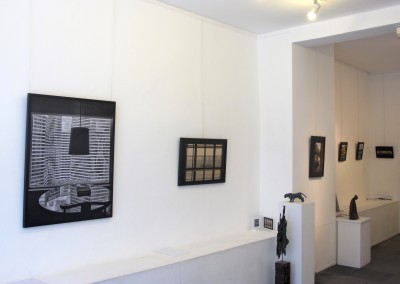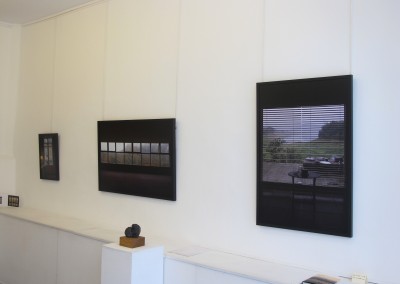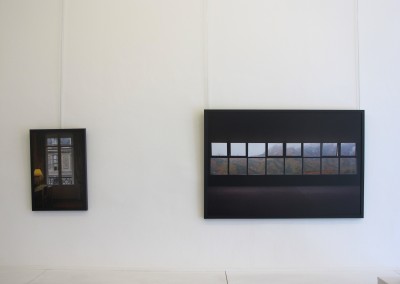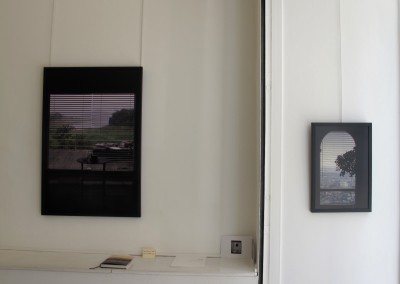Seung-Woo Baek
<les fenêtres>
“photographies”
du 12 au 30 juillet 2016
from 12 to 30 july 2016
De la fenêtre de la pensée
Photographe conceptualiste et artiste du land art, John Pfahl déclare en 1982 dans ses Picture Windows Series 1987-1981:«Toutes les photographies commencent à partir d’une fenêtre et finissent avec une fenêtre. Pareilles à notre vie, aucune image et aucune pensée n’existent sans fenêtre. Une fenêtre, c’est un miroir et un miroir, c’est une fenêtre.
Mes Picture Windows sont des miroirs qui rencontrent des fenêtres. Elles offres une perception et une illusion à travers les fenêtres, et une sensation éternelle pour ma vie. Ce sont les miroirs de mon âme que je garderai toute la vie, un cadre pour ma vie. »
Avec la série Picture Windows, photographiée par un appareil grand format 16 x 20″, John Pfahl reflète le monde à travers une grande vitre pleine de significations. Le monde, à son tour, a plus tard admiré ces œuvres qui ont exigé une longue période de réalisation. L’œuvre de John Pfahl est considérée comme particulièrement importante par les historiens de la photographie sous trois aspects. Tout d’abord, elle offre « une vue distanciée (a distanced view) » comme intervalles de la vie, puis « une observation passionnée (a passionate observer) » entre les différents regards, et enfin « une profondeur de la perspective (the depth of perspective chamber) » comme frontière de la vie. Autrement dit, la vitre est, en même temps, la réalité et un cadre pour l’illusion. Elle est claire (lucida) et obscure (obscura) dans le même temps.
The Windows (Les fenêtres) de Seung Woo Baek incarnent les intervalles de la perception et de la re-perception de sa vie. De nos jours, de nombreuses vitres s’inscrivent sur les photographies. Et de nombreuses photographies se construisent à partir de vitre. Pourtant, contrairement à ces fenêtres dotées de signification universelle, des fenêtres avec une signification particulière existent. C’est le cas des fenêtres de Baek. Ses fenêtres sont des fenêtres d’hôtel. Pour lui, les fenêtres d’hôtel transcendent non seulement le paysage existant physiquement, mais aussi l’encadrement d’une sensation esthétique de la vue. Les fenêtres d’hôtel de Baek sont plus qu’un paysage visuel et universel, mais une vitre de la perception. Pour lui aussi, la fenêtre est miroir et vitre en même temps. La fenêtre se situe sur l’avant-plan (foreground) et sur l’arrière-plan (background) de la vie de manière simultanée. Les fenêtres d’hôtel sont pour l’artiste un cadre plein de significations et une vitre de sensation qui se reflètent comme une structure de la vie.
L’hôtel est un endroit qui possède des fenêtres s’ouvrant sur le monde. À partir de ces fenêtres, l’hôtel reflète de nombreuses vies et ses significations. Les fenêtres de Seung Woo Baek rejoignent, dans ce sens, les fenêtres de John Pfahl. Bien que présentant un paysage, les fenêtres d’hôtel offrent l’occasion de pénétrer profondément la raison d’être des individus et de l’existence du monde. The Windows (Les fenêtres) de Baek est un espace de réalité et de l’illusion. L’artiste regarde de sa fenêtre, apprend et se retourne sur lui devant sa fenêtre. Dans sa fenêtre (in), à travers sa fenêtre (thru), à sa fenêtre (by) et depuis sa fenêtre (from), il jette son regard. La fenêtre devient un cadre de perception et de re-perception qui lui permet d’observer le moi et l’autre.
Un hôtel se situe à un emplacement qui offre une belle vue. Les gens souhaitent contempler cette vue, et se passionnent pour la beauté qu’elle offre. On cherche souvent une chambre d’hôtel qui présente une vue magnifique. Back est un artiste qui regarde ces gens, et qui se prépare dans ce contexte. Les fenêtres d’hôtel, ce sont des paysages de désir et de modernité. C’est une illusion de la réalité, et, de même, l’existence réelle d’une illusion. Les fenêtres d’hôtel sont profondément sombres. Toutes les fenêtres d’hôtel doivent être sombres. Plus l’obscurité est profonde, l’illusion devient sombre elle aussi, et le miroir reflétant le moi devient, à l’inverse, plus distinct.
Avec les hôtels d’aujourd’hui, le réel devient sans cesse l’imaginaire comme la caverne de Platon. La conscience représente un binarisme entre la réalité et l’illusion. Les fenêtres d’hôtel sont donc à la frontière et à l’intervalle de ce binarisme. C’est pourquoi, il n’est pas étonnant qu’une personne mettant sa vie en risque à une fenêtre, ou plutôt laissant sa vie en gage à la fenêtre, prend pleinement conscience de la fenêtre en tant que telle. La fenêtre raconte l’histoire de chaque individu, c’est le visage même de l’artiste. C’est la raison pour laquelle Back photographie les fenêtres, et la raison d’existence même de ses œuvres.
***
The Window
Being a conceptualism photographer and land artist, John Pfahl said in his <Picture Windows Series 1978-1981> in 1982, “all photos start with the window and end in the window. Like a life, there is no image of excluding the window and the thinking with no window doesn’t exist. Window is just a mirror and the mirror is just the window. My Picture Windows is my mirror with the window. It is a perception & illusion through the window and my everlasting sense of life. As the mirror of a mind that must be cared for a lifetime, it is the frame of my life.”
John Pfahl photographed “Picture Windows” using a big camera with 16 X 20 inch. He transmitted the world through the big and meaningful window, and the world admired his photo produced for a long time. His photos carried three meanings. One is ‘a distanced view’ as a gap of the life, another is ‘a passionate observer’ between visions, and the other is ‘the depth of perspective chamber’ as a boundary of the life. In Picture Windows Series of John Pfahl, these three factors that is the meaning of ‘window’ in the life are contained. Window is the reality and the frame of vision at the same time. It is also lucida and obscura.
“The Window” of Baek Seungwoo show the gap between the perception and re-perception for his own life. In today’s photos, there are many windows. Through many windows, the photo is made. However, unlike these windows, there is the windows which have special meaning over the general one. His window is the window of hotel. Hotel window is the frame of visible aesthetic over the physical view to him. In addition, the hotel window is the window of perception over the visible outlook and universal view. Window is the mirror and is the window to him. Also, the window is the foreground and the background of the life. He is a hotelier. For him, the hotel window is the window of apperception projected by the life’s structure and the frame of meaning.
A Hotel is the place where windows exist in the world. Telling many meanings of the life from that window is the hotel. The point of deeply analyzing the meaning of the life is the hotel’s window. The Windows of Baek Seungwoo meets the window of John Pfahl from that point. “The Windows” of John Pfahl is the space of reality and vision. He looks with his own window. That is, he looks in his window, through his window, by his window, and from his window. Window is the frame of perception and re-perception of looking the self and others.
Hotel has the good view point. People are excited at looking at nice view. So, they want to have a room with the excellent view at good hotels. Baek Seungwoo is the man of looking at such people and preparing these things. The window of the hotel is scenery of desire and scenery of modernism at the same time. Hotel’s window is the vision of reality and the substance of vision. Hotel’s window is deeply dark. Windows of all hotels must have the deep darkness. Deeper the darkness is, deeper the vision is. When the darkness is deep and the vision is deep, the mirror of the self is clear.
Today’s hotel becomes imagery like Platon’s cave. Realization is binominal of reality and welcome. Hotel’s window is the boundary of such the binominal and the gap of binominal. Accordingly, there is no wonder that the man who mortgages oneself to the window realizes the window. The windows, teaching who he is, his face. This is why he photographs the window and why these photos exist.






